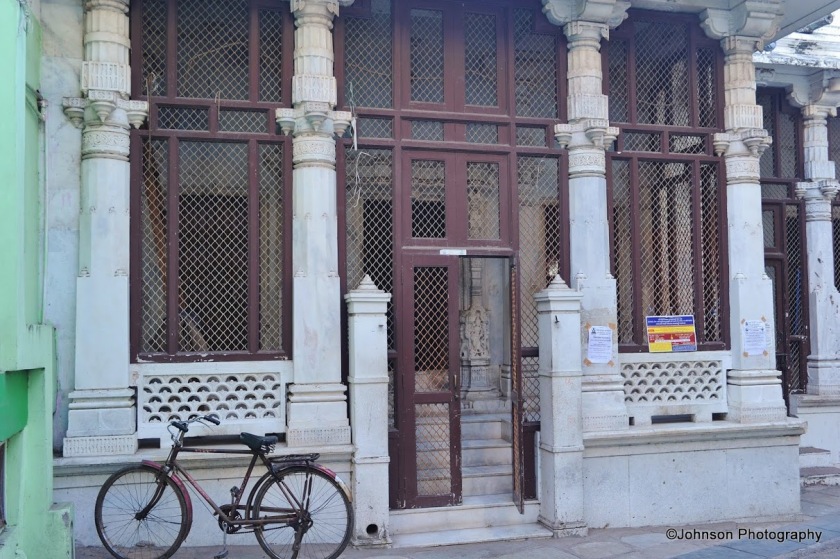A special feature of Ahmedabad is the plan of the old city, comprising numerous ‘pols’ or self- contained neighborhoods, sheltering a large number of people. A pol normally comprises of many families of a particular group, linked by caste, profession or religion. These typical urban centers or neighborhoods are an integral part of the old city of Ahmedabad. The old city of Ahmedabad is made up of around 360 pols within a fortified compound. In the recent past, families have started moving out to live in modern houses away from the city center, but many of them still feel a strong bond to the closely-knit communities of the pols where they have grown up. These pols are traversed by narrow lanes, usually terminating in squares called ‘chowks’, consisting of a community well and bird feeders called ‘Chabutro’. Some pols have intricately carved temples as well. Each pol has its own distinctive architectural style and motifs.
Each pol is protected by a gateway, closed at night as safeguard against thieves. Inside each pol is one main street, with crooked lanes branching on either side. Most vary in size from five or ten to fifty or sixty houses. Pols are almost entirely inhabited by Hindus, in some cases by a settlement of families belonging to one caste, and in others by families of several of the higher castes.
Pols were originally made as a protection measure when communal riots necessitated greater security, probably dating from 1738, during the Mughal-Maratha rule in Ahmedabad. A typical pol would have only one or two entrances and also some secret entrances known only to people residing in the respective pol. Each pol generally has its own watchman and its own sanitary arrangements. The affairs of the pol were managed by a group of people. The house property in the pol is to some extent held in common. Formerly no one could sell or mortgage a house to an outsider without first offering it to the people of the pol. Though this rule was not kept later, inmates of a pol sold their houses to same caste people. On weddings and other great family occasions, each house holder is expected to feast the whole pol, and in some cases, all the men of the pol.



































Some pols contain old beautiful houses (havelis) with internal courts having intricate wooden carved facades with columns and fresco work done around court walls and ceilings. Today the owners of these havelis, being unable to bear the heavy maintenance costs have either sold their properties off or have let them fall to ruins, while they have settled in other places. The heritage cell of Ahmedabad Municipal Corporation is taking the initiative in restoring, some of these havelis.










The best way to explore the pols is to join for a ‘heritage walk’, an initiative of the Municipal Corporation, to unveil the heritage of the city to tourists and citizens. The walk commences from the Swaminarayan Temple, Kalupur and concludes at the Jama Masjid. Hence this walk is popularly known as the journey of ‘Mandir to Masjid’. The walk commences at 8.00am and concludes at around 10.30am, which also includes a slide show of 15 minutes. The details can be obtained from the Ahmedabad Municipal Corporation website.

Very interesting!
Is there a special meaning to Chabutro?
LikeLike
In Gujarati language a bird feeder is called Chabutro.
LikeLiked by 1 person
I meant why is there one in each pol? Not a fountain or statue, etc., but specifically a bird feeder?
LikeLike
When they build those house they have to cut many trees, where many birds were living. So they build these bird feeders to rehabilitate them.
LikeLiked by 1 person
Wow, excellent! Thank you!
LikeLiked by 1 person
You take fabulous photographs, thank you for sharing.
LikeLike
Thanks for you visit and the compliments.
LikeLiked by 1 person
Lovely! Perhaps one day I shall take the Mandir to Masjid walk.
LikeLike
Yes, really worth it.
LikeLike
Splendid I adore
LikeLike
Thanks.
LikeLiked by 1 person
Interesting photo tour! Fascinating city
LikeLike
Thanks.
LikeLiked by 1 person
Vos photos sont magnifique!
Merci a vous de les partager pour nous permettre de découvrir de si beaux endroits.
LikeLike
Thank you very much.
LikeLiked by 1 person
An interesting exploration. Thanks.
LikeLike
Glad to know that, you liked it.
LikeLike
How beautifully captured. I really liked the chabutro concept… and carvings
LikeLike
Thanks.
LikeLike
These buildings are gorgeous! Can you tour the inside? Is there a guided walking tour through these pols?
LikeLiked by 1 person
Yes there are regular walking tours through these pols. It is normally arranged from Swami Narayan Temple, Kalipur.
LikeLike